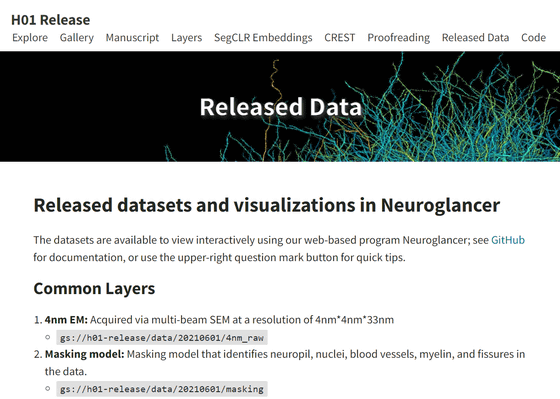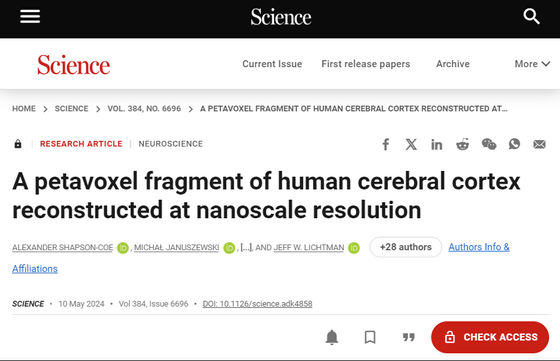Researchers from Harvard and Google successfully 3D-map a cubic millimeter slice of the brain with nanometer resolution

A research team led by Jeff Lichtman, a neuroscientist at Harvard University, has published a 3D map of brain samples sliced to a thickness of 34 nanometers and constructed using an electron microscope. At the time of writing, the 3D map covers one cubic millimeter of the brain, and the data size is a whopping 1.4 petabytes (1,400 terabytes).
Released Data | H01 Release

A petavoxel fragment of human cerebral cortex reconstructed at nanoscale resolution | Science
https://www.science.org/doi/10.1126/science.adk4858

Cubic millimetres of brain mapped in spectacular detail
https://www.nature.com/articles/d41586-024-01387-9
The 3D map shows part of the human cerebral cortex, the part of the brain involved in learning, problem solving and processing sensory signals. It is just about one cubic millimeter in volume, and the map contains about 57,000 cells and 150 million synapses , with a data size of about 1.4 petabytes.
Lichtman and his team used a fragment of brain taken from a 45-year-old woman who had undergone surgery to treat epilepsy. The sample was soaked in a preservative and stained to make the cells easier to see, and the team cut the sample into about 5,000 thin slices just 34 nanometers thick and photographed them under an electron microscope. Google neuroscientist Viren Jain and his team used AI to build a 3D map from the electron microscope images.
3D rendering of millions of neurons, color-coded by neuron size.

There are an astonishing 5,600

By examining the 3D map, we can access a huge amount of data that can help us understand the human cerebral cortex. In fact, when we looked closely at this 3D map, the research team reported that they found non-conventional neurons that form up to 50 connections with each other, neurons that wrap around themselves to form knots, and pairs of neurons that are almost perfect mirror images. However, it is unclear what role these neurons play.
The team plans to create similar maps of brain samples from other people, but it will take decades to create a map of the entire brain. 'A deeper understanding of how the cerebral cortex works may provide clues for treating some psychiatric and neurodegenerative diseases,' the team said. 'This unprecedentedly detailed map will reveal new rules of neuronal connectivity and help elucidate the inner workings of the human brain.'
Related Posts:
in Science, Posted by log1i_yk







